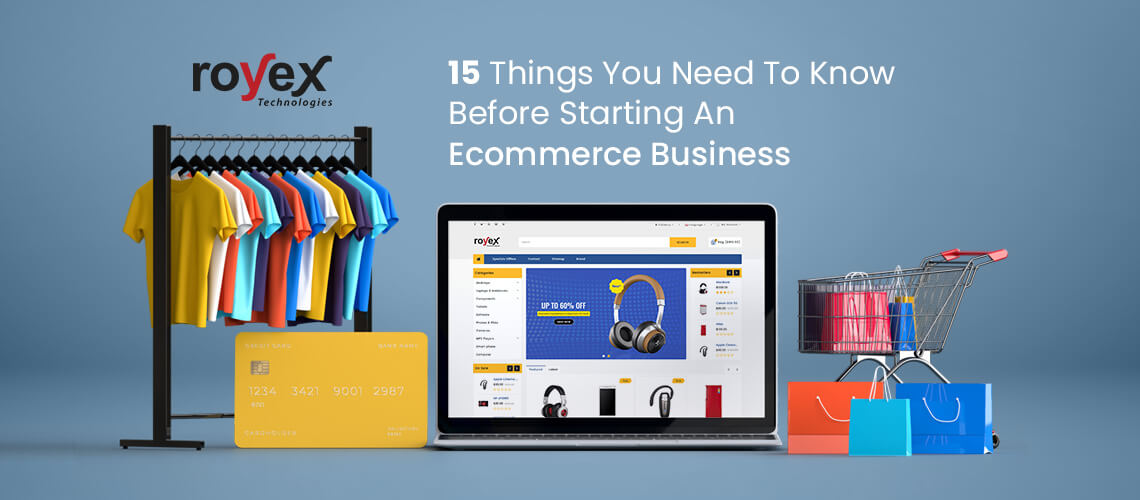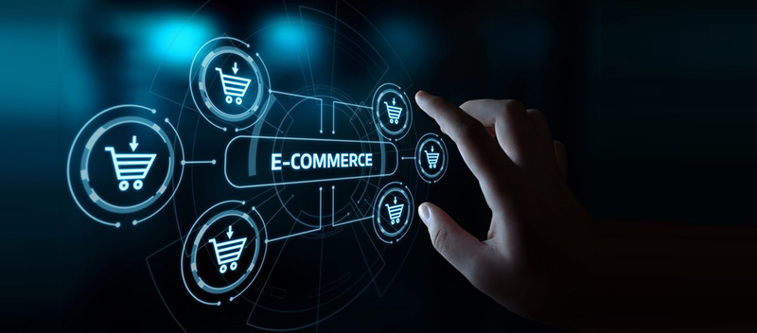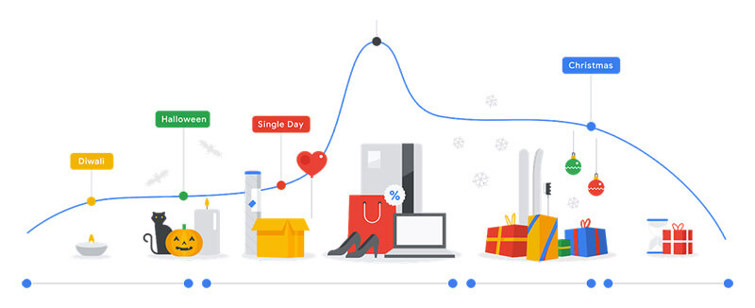
15 Things You Need To Know Before Starting An Ecommerce Business
With the emergence of ecommerce platforms, starting an ecommerce company from the ground up is no longer essential. However, there are quite a few things to keep in mind to achieve progress. A popular question among potential entrepreneurs is what precautions must be taken before opening an online marketplace. Here's a checklist of everything you can do before opening your ecommerce website to ensure it generates interest and revenue.
Get the ten basics right

These are the steps that you need to take before starting your ecommerce business. You need to ensure the proper setup of these basics, or else your business will fail.
1. Begin with the company's name
The first step (after deciding what you want to market, of course) is to come up with a great, unforgettable brand name that no one else has. You will check to see whether the name is still in usage by doing a corporate name scan. If you've decided on a name, make sure to register it. (This would happen immediately in the state where you file the papers, whether you create an LLC or corporation.)
2. Secure your website and domain name
If your company name isn't available as a domain name, pick a URL that's simple to say and spell and applies to your industry.
Your eCommerce site's design could be your most expensive business cost. However, you must ensure that it is not only pleasing to the eye but still practical. To start, there are out-of-the-box eCommerce solutions like Shopify, but if your requirements are more complex, you may need something more custom-made.
3. Choose the best business structure for the company and register it
When it comes to the layout of your business, you have many options:
- Sole proprietorship
- Partnership
- LLC
- Corporation
As a sole proprietor, moreover, your interests are at stake. If your firm is also prosecuted, the judge can be able to take your personal belongings if your company is unable to pay its debts. Both the corporation and the LLC have tax incentives by separating you and your properties from the firm.
You may either file on your own by filling out the requisite IRS business structure paperwork or pay a business filing firm to do so for you. Another choice is to hire a prosecutor, although this is always overkill for the needs of the ordinary small business owner.
4. Obtain an Employer Identification Number (EIN)
To open a company bank account and pay your business taxes in April, you'll need an Employer Identification Number (EIN). Your EIN is similar to the company's social security code: it's a one-of-a-kind number that distinguishes your company and assists you in filing vital paperwork. If you have workers or not, any company wants one.
5. Apply for business licenses and permits
You would also require some business licenses and permits if you run an eCommerce business. Check with your area, district, and state to see what kind of sales tax licenses or home business licenses you'll require, and make sure you have them before you start selling.
Since you'll be up to a lot of competition if you market goods online, it's in the best interest to find the best standard and pricing for the products you sell or the resources you use to make them. Scan around before you locate a vendor with whom you want to make long-term sales.
7. Have a head start on marketing
And if your site isn't up and running yet, it's a smart idea to start setting up social networking accounts and creating blog material now, so you don't have to start from scratch on Day 1. You should have a "coming soon" tab on your website where interested people can sign up for alerts.
8. Use the Right Technologies to Boost Productivity
Before you launch your eCommerce business, experiment with CRM, accounting, project management, and email marketing tools that you can integrate into what you're doing once you're up and running.
9. Make sure you have enough inventory
Ensure you have enough inventory to launch, whether you have a warehouse full of products, or your inventory is stored in your garage. Not knowing how much you'll need can be difficult, but in general, it's better to have too much inventory than not enough. Keep track of how the revenues grow so you can plan for upcoming orders.
10. Ensure that the business is compliant
Stuff can travel at the pace of light once you start your eCommerce venture. If you've registered or formed an LLC, don't forget to submit your annual report and pay your annual business permit fees. Place certain dates on the calendar if necessary to keep on top of them.
5 Things To Do For Your Ecommerce Business

One of the most critical stages in starting an E-Commerce company today is determining precisely who the target customer is and ensuring that all marketing strategies and budgets are solely focused on recruiting, entertaining, and ultimately retaining that audience.
1. Finding Profitable Customers

When it comes to marketing a commodity, the worst error you can create is to believe that it is for everybody. If you want to grow your company successfully, you'll need to describe your potential customers in as much depth as possible.
There are several causes for online retailers to be hopeful about the prospects of their company. The below are some of the explanations why online shopping is becoming the chosen method:
A new business's priority is to identify a potential demographic. Lacking a good vision of the customer you're aiming to reach translates to a waste of marketing and promotional money that might have otherwise culminated in positive brand awareness.
Basic SEO skills and a good content campaign might get you 100,000 random hits straight away, but they're not worth as much as 500 qualified hits from people who are actively searching for your products or services.
This saves you time and money by eliminating the need to reach a larger audience and only focus on new clients. Consequently, whether you realize what the target customer wants, you will produce the same sales with less money.
2. Differentiation
The goal of online marketing is to create and sustain your brand. You provide a stable base for your company and clientele by doing this correctly. It is almost impossible to stick out in today's industry, where there are many online vendors for virtually any commodity eligible for purchase.
But, how can you make yourself stand out?
Make Use Of Content To Establish Your Brand
It's critical to keep the clients in today's dynamic environment, where there's still another choice. To attract consumers to your brand and then market to them on the backend, use engaging and eye-catching videos.
This will assist you with making the brand resonate with your target audience. Telling a tale is one of the most effective ways to attract people's interest in your business. Stories are successful because they leave a lasting impression on consumers and present the company in a strong, unforgettable way.
Images and Videos of the Products
Aside from the BUY icon, the product picture is the most critical aspect of a product website. People still like to see as much of what they're buying as possible.
We will guarantee that even though you compose the finest product summary globally, without a photograph, sales would be minimal. It's also crucial that all of the brands follow the same theme. This will aid in the development of an identity for your company in the minds of your customers.
Why do people purchase from YOU, according to your USP?
Do something completely special and different that people would want to warn their friends about it. Now, the commodity does not have to be unique; what counts is how you present it.
These may be anything from complimentary shipments to cash on arrival or even simple refunds that persuade a spoiled-for-choice buyer to order from you again and again.
3. Tracking your funnel analytics
Businesses, like people, go through different periods of their lives. Consider a newly opened store. It needs people's support right away, so devoted team members stand outside and wave to passers-by. If a customer shows interest and approaches them, they invite him into the store and lead him around. He selects one, and they choose and display it. He either demands another or decides he likes it and wants to purchase it. He pays at the counter and walks away from his purchase. In digital businesses, you want to get the intended audience's focus right away (i.e., branding/attention/awareness). After that has built up, each visitor is greeted with a nice website (i.e., traffic/interest). He searches for and evaluates all of the products/services available (i.e., research/evaluation), selects the one he wants (i.e., shortlist/desire), and purchases (i.e., action/sale). As soon as he pays, the commodity goes into the packing and distribution phase, which takes a few days.
As a result, the four points – Attention, Interest, Desire, and Action – form a funnel rather than a conventional flowchart. Each segment's size represents the size of the audience it represents. When the crowd grows closer to conversion, the frequency and scale of the audience decline, indicating that although a significant amount of people may pay attention, only a small percentage convert into purchases. It's similar to how a large number of people can RSVP to a party, but just a few show up.
The funnel's mouth is big enough to swallow users/leads for you. Then they head south, with some of them dying along the way. Just a few people make it to the bottom and are assimilated into the business. As a result, the publicity team would concentrate on increasing the mouth's size or decreasing it.
Simplistic Funnel
Since arriving on an E-Commerce website, a user's easy flow is predictable. He navigates to a certain category, browses the items, selects one, reviews it, attaches it to his cart, and completes the purchase using his chosen payment system. Many people leave this flow at various points, and we strive to fill in the holes at each point to keep the crowd from leaving.
Consider a funnel with holes at various heights and depths. Each hole is a specific size, and we aim to fill them partly or entirely to prevent materials from dropping out. The gaps on lower levels and greater scale are the smallest babies that need urgent and continuous care.
Advanced Funnel
The funnel is made up of people who are more willing to convert. Simply put, some can purchase, be considered, and be referred. Users farther down the funnel (top-funnel users) show signals of interest or possible conversion chances. For instance, when you attract visitors to your website (i.e., catch their attention) and they begin to spend time there, either searching through categories and items or concentrating on one product and reviewing the specifics, you realize their interest has been piqued. Such a sustained or repeated fascination grows into a compulsion to own it. When an urge is high enough and accompanied by invitation, it will lead to motion.
When it comes to time on site, it's a common misconception that the more time you get, the better. Don't get carried away – if the text is only 1000 words long and they read it for 20 minutes, it's not true, and they most likely didn't close the tab. Thus, based on the total time spent on-site by a person during non-offer non-season times, set a threshold and monitor the users whose length exceeds it – these are your top-funnel entries.
The number of items seen by a customer indicates that he is involved in your company's services but is always looking for the best match for himself, which is a positive indication to some degree. The more products he looks at, the more likely he is to convert. As a result, any product he looks at would lead him to a new product, preferably through product recommendations.
4. Seasonality

Seasonality is particularly significant in the world of e-commerce. It is frequently the source of otherwise mysterious revenue that raises and decreases.
Many unfamiliar with the industry's normal cycle can misdiagnose a drop in revenue, negatively impacting the overall company. However, with a basic knowledge of seasonality and the ability to meet the right customers at the right moment, seasonality may be used to improve business efficiency.
Seasonality will happen at any time interval, whether it's periodically or regularly. Each type of company has its own set of requirements. The trick to comprehending the trends that a specific company encounters is to use historical evidence to forecast when these variations can occur and then strategize accordingly.
Consumer behavior can vary according to the season. Many companies, for example, see a drop in activity over the summer. Meanwhile, several companies profit from the Golden Quarter, which runs from October to December and is characterized by a buying spree and selling seasons that last until December.
When we examine traffic patterns and various habits (conversions, bounces, taps, and so on) on our websites, we want to improve several primary success metrics we want to improve, such as the conversion rate. We want to reduce the bounce rate on the search and social networking and the prices. As a result, targeting the right demographic and raising brand value are critical.
Seasonal influences are, therefore, a powerful influence for firms who believe they are resistant to them. Seasonality may be described as the time of day, day of the week, and day of the month, rather than only special occasions.
5. Big data analytics
It all begins with understanding data as a valuable resource! Today's technology allows us to gather data during any stage of the customer purchase, from the first click that led to a website visit to the Lifetime Value (LTV) assigned to each user and commodity. Any of these data points has the potential to offer immensely valuable and real-time insights into online and offline marketing and sales. The consistency of data obtained and consumed determines whether the data first strategy succeeds or fails.
The conventional method to retail decision-making – a smaller dataset hypothesis extended to a broader population – is being challenged by Big Data. This method is largely focused on causation analysis.
The Big Data method reverses this theory, expanding the study range to n=all (or as close as possible). The computing capacity has increased dramatically, allowing even massive petabyte databases to be analyzed in seconds. Proving correlation may be time-consuming and costly in terms of missed chances as massive volumes of data are collected. Given the essence of retail purchases, correlation is a highly successful strategy that can drive incremental sales using the Big Data method.
When we look at data cohorts, we must consider both causation and correlation. If we're looking at the conversion funnel on a website, any reduction in conversion rates along the way must be carefully investigated to determine what's causing it. For one customer, for example, the conversion rate between add-to-cart and cart checkout had fallen by 50%. Further investigation revealed that the decline was triggered by the movement of the coupon codeshare from the beginning of the cart to just before checkout. The factors are infinite, but they must all be investigated and corrected as soon as possible to guarantee there are no funnel leaks.
Royex Technologies, a leading Website, Mobile App, and E-commerce Development Company in Dubai, have certified developers who can bring reality to any of your ideas. We have experience developing over 300 projects for our clients in the GCC, including several E-commerce websites, service applications, etc. So we have the expertise perfect for your e-commerce requirements. If you need an eCommerce website with SEO optimizations, feel free to call us at +971566027916 or mail us at info@royex.net, and we can send you a proposal based on your idea.





